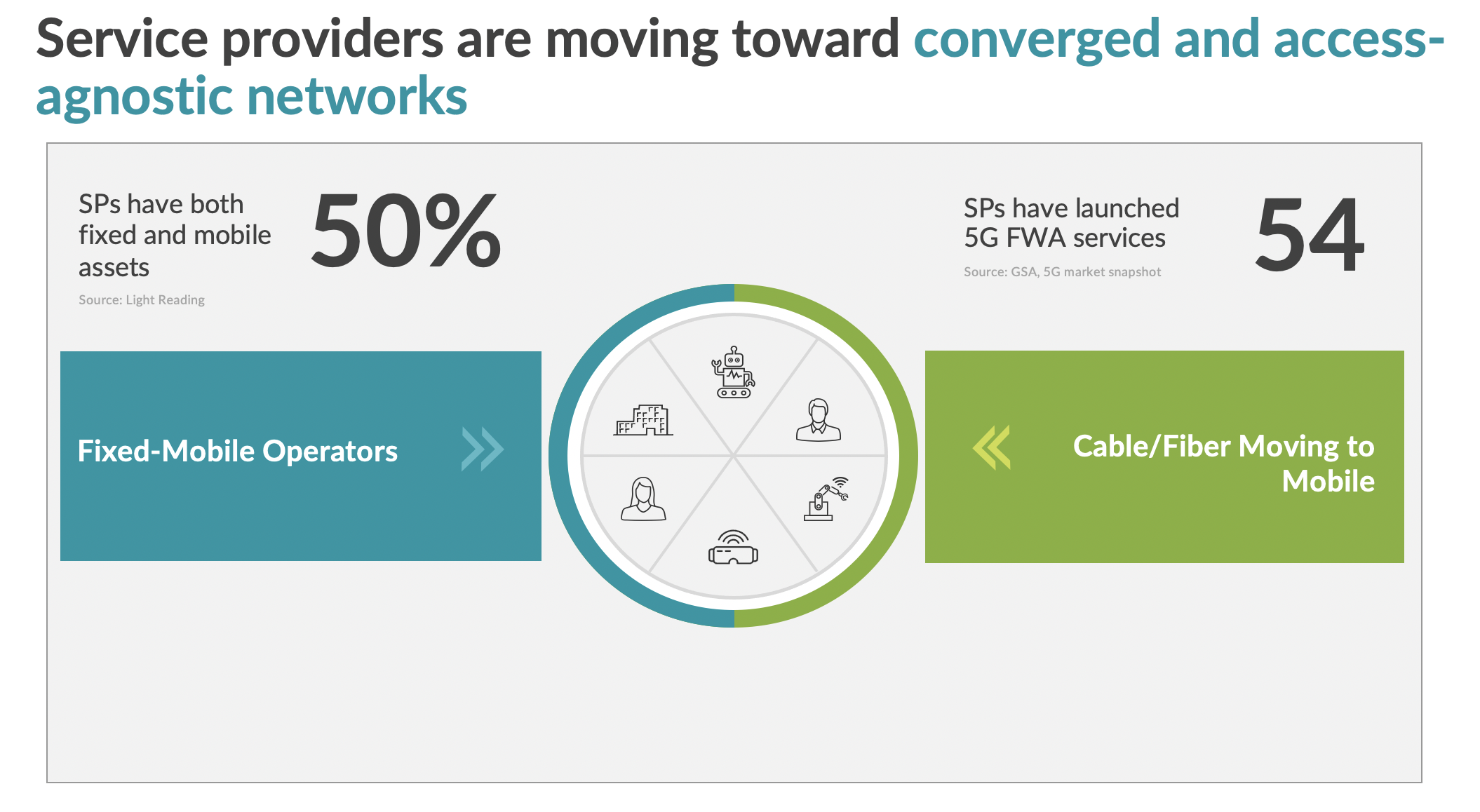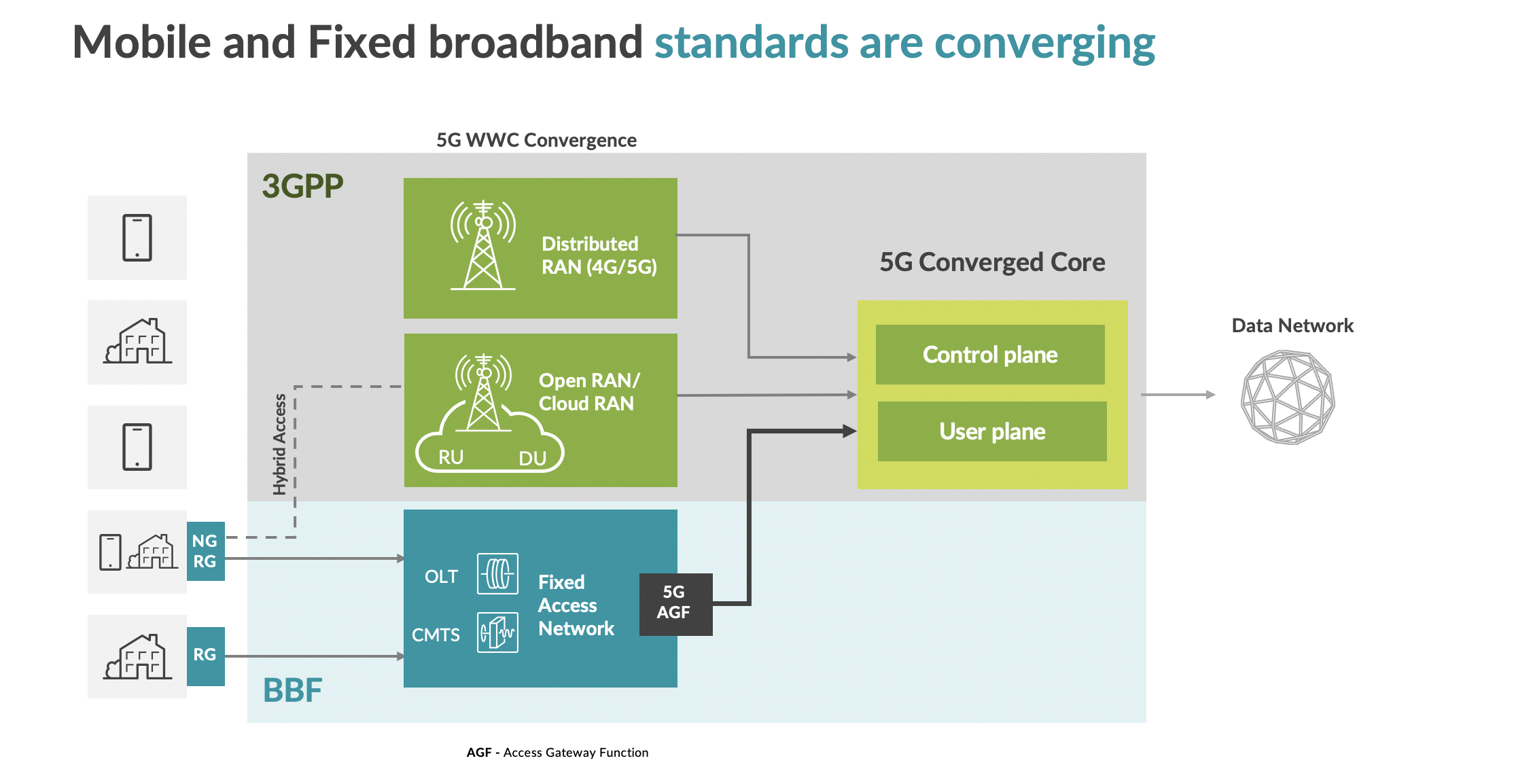Imagine that the network infrastructure is a highway with two parallel roads going in the same direction: one for wireless and the other for wireline traffic. There’s a big concrete barricade between them. Now, let’s say there’s a pandemic. Virtually overnight, traffic patterns change wildly. There’s less commuting traffic (where did rush hour go?) and more big-rig traffic (everyone’s shopping online). The big-rig traffic could benefit from more lanes, but jumping the concrete barricade isn’t an option.
When transportation systems are rigid and traffic becomes more complicated and dynamic, what are the options?
A complete rebuild of the physical roadway is one option. But that’s expensive, disruptive and will take too long. Worse, the same result could occur without the agility to adapt to future traffic patterns.
Fortunately, when it comes to the network infrastructure, there’s an easier choice: Wireless Wireline Convergence (WWC). This emerging set of standards turns constrained, siloed systems into a unified stack for service delivery, using an access-agnostic cloud-native IP fabric at the network access and edge. WWC abstracts mobile or fixed-line services.
WWC doesn’t break down silos — it rises above them.
WWC will play an increasingly important role in the evolution of the network access and edge. It will help enable an exhilarating degree of freedom in planning and executing business strategies, including:
-
- Distributing network resources where and when they are needed
- Turning up services faster at the edge
- Drastically reducing recurring operational expenses (at last!)
- Turning on a dime to deliver the perfect “road” to meet changing traffic needs
Please, Hold the Groaning—WWC isn’t an FMC Retread
WWC’s predecessor, Fixed Mobile Convergence (FMC), was designed to bridge services across siloed wireless and wireline infrastructures. But FMC failed to gain traction, mostly because software was tightly integrated with existing siloed platforms.
WWC has it right because:
- WWC is a set of standards created by the 3rd Generation Partnership Project (3GPP) and the Broadband Forum (BBF).
- WWC enables migration from two distinct technology implementations for wireless and wireline to a single converged network and not all solutions are created equal. A successful migration requires a comprehensive and consistent BNG implementation.
- The standards are based on convergence — without replacing or even disrupting — wireless and wireline services in a single service stack.
- WWC supports co-existence, interworking and interoperability, which means service providers have flexibility in how, where and when they move toward convergence.
Major service providers are already looking at how WWC can support their strategies, including Telstra, the leading provider of mobile, fixed, internet and streaming content in Australia.

A senior member of Telstra’s mobile and product engineering team says, “As services become more complex and have both mobile and fixed access sides, we need to have a common stack. We are also shifting from a traditional connection-oriented network design model to a services-based design model that aligns with the 5GC. We see WWC as playing a key role in this transition.”
WWC Specs the Rosetta Stone for Convergence
A Heavy Reading report produced for Juniper Networks describes the industry momentum behind WWC: “As they seek to expand their reach to new markets and customers with wireless technology, especially 5G mobile, [Communications Service Providers] are increasingly embracing WWC so they can offer a full panoply of services over a consolidated network infrastructure with a common single stack. They are accomplishing this by rearchitecting their network access and edge domains based on disaggregation, virtualization and cloudification.”

Here are some of the key WWC specifications. Notably, TR-470.
23.501: Defines the architecture for 5G Systems (5GS)
23.316: Defines Wireless and wireline convergence access support for 5GS
TR-470: Defines the high-level architecture for wireline access integration with the 5G Core (the Heavy Reading report describes TR-470 as “the Rosetta stone” of the WWC standardization work)
TR-456: Defines functional requirements of the Access Gateway Function (AGF)
TR-124: Defines the functional requirements for broadband Residential Gateway devices that are capable of supporting voice, video and data
WT-458: Defines control user plane separation (CUPS) for 5G WWC nodes
Note: The CableLabs standards body is also working on a WWC architecture for cable access (WR-TR-5WWC-ARCH-V03)
All Roads Lead to a Better User Experience
Leading service providers around the world are already working to implement different aspects of WWC. Going beyond the obvious advantage of a converged network with respect to operational costs, WWC has the ability to deliver new, differentiated service experiences.
Just ask BT Group, the UK’s leading telecommunications and network provider who has launched their new Halo 3+ service offering with an unbreakable hybrid option that backs up customer fixed broadband connections with mobile service from EE, one of the UK’S most reliable mobile networks.
A member of the BT Group’s research team says, “In our research, convergence is less about pure business economics and more focused on how we optimize our network assets to deliver services regardless of the access used. The ultimate goal is the delivery of the best possible user experience to our customers.” That said, BT adds, “It’s critical that the costs of routing broadband traffic over integrated converged solutions must be very close to current fixed broadband costs to be viable.”
Here are two ways that WWC supports that superior user experience:
- Consistent, access-agnostic service experience: Customers will enjoy a better experience when they can get consistent features across multi-access networks and different customer premises equipment.
- Improved application experiences: WWC makes it possible to aggregate available wireless and wireline bandwidth into one logical link that can improve speed, QoS and reliability.
Let’s Start Calling it a Broadband “Nimble” Gateway (BNG)
At Juniper Networks, we’re deeply involved in the evolution of WWC standards — and we’re taking concrete steps to make sure our customers can take advantage of them. Consider our MX Series portfolio, the world’s number one router and first choice of service providers for BNG (excl. China). Juniper brings its industry-leading disaggregated wireline BNG stack to the table and a 5G UPF/AGF functionality to enable a seamless migration to WWC.
Unlike some vendors, we’ve built our MX Series routers to support a wide range of requirements in diverse, multi-vendor environments, so we’re ready to support service providers’ WWC journeys. We deliver:
- Architectural evolution: We’re evolving our architecture to take advantage of virtualization, disaggregation, distribution and convergence with WWC to support particular strategies and timetables. With a nimble BNG, operational efficiency increases, bandwidth costs per subscriber are lowered, and turn up services are faster and keep resource provisioning in line with demand.
- Bandwidth explosion – One can almost hear the loud chomping sound of bandwidth being consumed at the network edge—from subscribers, devices and applications. Juniper has 400GbE interfaces on multiple MX platforms and COVID-19 has exponentially increased the bandwidth requirements.
- Investment protection: When service providers strategize the evolution of their networks to single service stack convergence, future proofing is crucial. All MX platforms are based on the Junos Trio Chipset and Juniper Networks Junos® operating system. That means they’re upgradeable, scalable and designed for interoperability and adherence to standards.
Taking a Different Road Makes All of the Difference
It’s an extraordinary time for service providers around the globe. They are finally seeing a wide-open road for convergence of wired and wireline services in a single service stack. Telstra plans to be a WWC early adopter: “We are developing a technology platform to build and test WWC capabilities. This will enable us to validate use cases and understand the service demands. These services will be supported by a rich ecosystem, open APIs and will target both consumer and enterprise market segments.”
By taking advantage of WWC, service providers can finally break down the walls separating yesterday’s siloed architectures and build a more versatile, powerful network for the future. Stay tuned for future blogs on this topic.

























